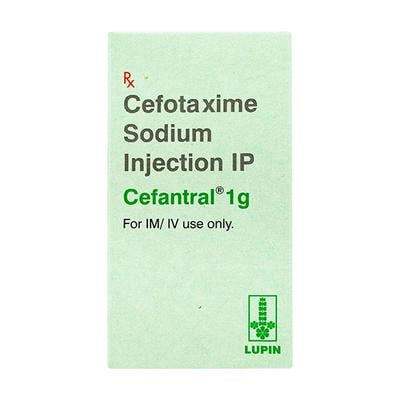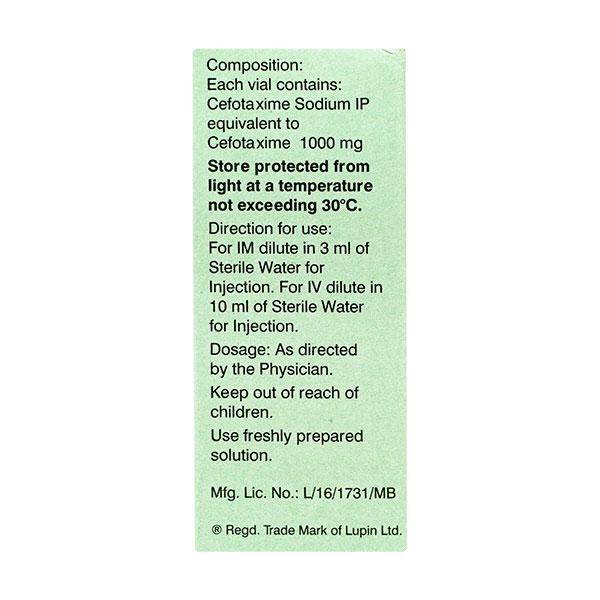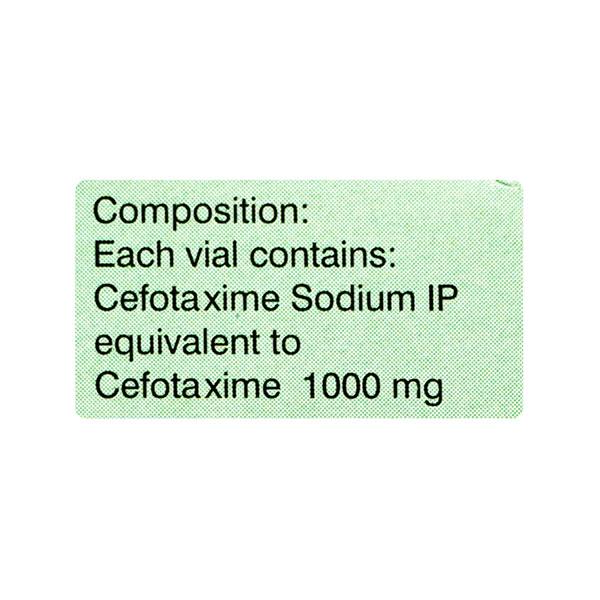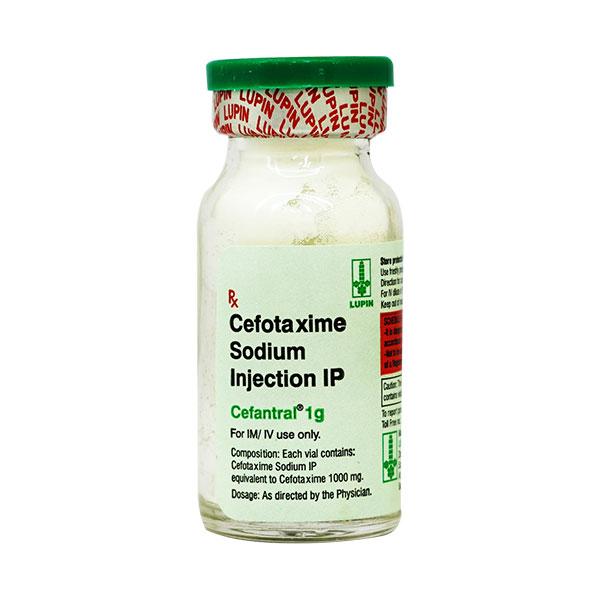

Netmeds First Membership
Quick Links
Introduction About CEFANTRAL 1GM INJECTION
CEFANTRAL 1GM INJECTION contains Cefotaxime which belongs to the group of medicines called Antibiotics. It is used to manage serious bacterial infections such as blood stream (septicemia), bones (osteomyelitis), heart valves (endocarditis), membranes covering the brain (meningitis) and lining of the abdomen (peritonitis), lungs (pneumonia), skin and soft tissue, urinary tract, genitals (including gonorrhea), blood (bacteremia), Lyme disease (borreliosis), an infection primarily caused by tick bites and also to manage infections following surgical operations.
Before receiving this CEFANTRAL 1GM INJECTION, inform your doctor if you have liver, kidney problems or high blood pressure. Consult your doctor for advice.
Pregnant and breastfeeding women should consult their doctor before receiving this medicine.
Your doctor will administer the right dose depends on your child’s age, body weight and severity of the infection. Consult your doctor for advice before receiving the medicine.
Management with high doses of CEFANTRAL 1GM INJECTION, particularly in patients with kidney problems, has been known to cause loss of consciousness, abnormal movements and convulsions and brain disease. Consult your doctor before receiving the medicine.
The common side effects of receiving this medicine are nausea, vomiting, stomach pain, diarrhea and injection site pain. Consult your doctor if any of the above symptoms worsens.
Uses Of CEFANTRAL 1GM INJECTION
- Used to manage patients with serious bacterial infections
How CEFANTRAL 1GM INJECTION Works
CEFANTRAL 1GM INJECTION works by inhibiting the biosynthesis of a protective layer of a bacterial cell wall called peptidoglycan. This leads to interruption of cell wall synthesis, consequently leading to inhibition in cell growth and cell lysis.
How to use CEFANTRAL 1GM INJECTION
CEFANTRAL 1GM INJECTION will be injected intramuscularly (into a muscle) or intravenously (into a vein) by your doctor or nurse. Your doctor will administer the right dose depends on your age, body weight and severity of the infection.
Side Effects Of CEFANTRAL 1GM INJECTION
Common
- nausea, vomiting
- stomach pain
- diarrhea
- sore, pain in muscle (injection site reactions)
- headache
- dizziness
- anemia or other changes in the blood (which can cause sore throat and mouth ulcers or a tendency to bleed or bruise easily)
- temporary changes in liver function, inflammation of the liver
- painful joints and thrush
- swelling around the area of infection or inflammation of the vein
- blood clot in a vein or irregular heart rhythm
Uncommon
- sudden fever and shivering (Jarisch-Herxheimer reactions)
- skin rash (nettle rash), itchy skin,skin redness
- soft stools
- convulsions
- cramps
- drop or elevation of the number of certain blood cells such as eosinophilia, leucopoenia, thrombocytopenia
- increase in enzymes
Rare
Contact your doctor immediately, if you have experience any of the following side effects:
- severe allergic reactions symptoms such as rash, itching, fever and, peeling skin, swelling of the face and difficulty breathing
- inflammation of the inner lining of the colon (colitis) symptoms such as diarrhoea, abdominal cramps or pain, nausea, dehydration, fever or bloody, watery diarrhoea
- stevens-Johnson syndrome or toxic epidermal necrolysis symptoms such as widespread rash with blisters and peeling skin
- severe, persistent diarrhoea
- superinfection
How To Manage Side Effects
Nausea and Vomiting:
Try to take this medicine with or just after a meal or a snack. Stick to simple meals. Avoid eating rich or spicy food.
Stomach pain:
Rest and relax. Eat and drink slowly or try to have smaller and frequent meals. Keep a heat pad on your stomach. Do not self-manage on your own and consult your doctor if the symptom did not improve on its own.
Diarrhoea:
Drink lots of fluids, such as water or fruit juices to keep yourself hydrated. Avoid taking any medicine on your own for managing diarrhoea. Consult your doctor if the symptom did not improve.
Headache:
Rest and relax. Drink plenty of fluids such as water or electrolytes. Apply a pain-relieving balm on your head if required. Consult your doctor if the symptom did not improve.
Dizziness:
Try to rest and relax. Get enough sleep. Avoid driving or operating any tools or machines while you are feeling dizzy. Do not consume too much of alcohol, as it can aggravate your dizziness. Consult your doctor if the symptom did not improve.
Warning & Precautions
Pregnancy
CEFANTRAL 1GM INJECTION should be used with caution in pregnant women unless considered necessary. Consult your doctor before receiving this medicine.
Breastfeeding
CEFANTRAL 1GM INJECTION is not recommended for use in breast feeding women. Consult your doctor before receiving this medicine.
Driving and Using Machines
Do not drive or use any tools or machines while receiving this CEFANTRAL 1GM INJECTION, it may cause involuntary muscle contractions, dizziness or alertness problems.
Kidney
CEFANTRAL 1GM INJECTION should be used with caution in patients suffering from kidney problems. Consult your doctor before receiving this medicine.
Liver
CEFANTRAL 1GM INJECTION should be used with caution in patients suffering from liver problems. Consult your doctor before receiving this medicine.
Allergy
Do not receive CEFANTRAL 1GM INJECTION if you are allergic (hypersensitive) to Cefotaxime or any other ingredients of this medicine.
Heart Disease
CEFANTRAL 1GM INJECTION is not recommended in patients with heart diseases, problems with heartbeat or severe heart failure. Consult your doctor before receiving this medicine.
Others
Before receiving this medicine, inform your doctor if you:
- are on low salt diet
- have blood transfusion
- are a diabetic patient
Use in pediatrics:
Your doctor will administer the right dose depends on your child’s age, body weight and severity of the infection. Consult your doctor before receiving CEFANTRAL 1GM INJECTION.
Use in geriatrics:
CEFANTRAL 1GM INJECTION should be used with caution in elderly patients. Consult your doctor before receiving this medicine.
Interactions
A. Drug - Drug interactions:
Before receiving CEFANTRAL 1GM INJECTION tell your doctor if you are taking any of the following medicine:
- mezlocillin, azlocillin, streptomycin, neomycin, gentamicin,kanamycin, amikacin or tobramycin (used to manage bacterial infections)
- furosemide, etacrynic acid or other strong diuretics (used to get rid of excess water from the body
- probenecid (used to manage gout)
Overdosage:
It is unlikely to get an overdose since it is administered by your doctor or nurse. If you experience any unusual reactions, consult your doctor immediately or visit the nearby hospital.
Synopsis
| Drug | : | Cefotaxime |
| Pharmacological Category | : | Cephalosporin |
| Therapeutic Indication | : | Manages serious Bacterial infections |
| Dosage Forms | : | Injection, Dry syrup, Tablet |
More Information
- Keep this medicine out of reach of children
- Store at a room temperature
FAQs About CEFANTRAL 1GM INJECTION
Is CEFANTRAL 1GM INJECTION same as penicillin?
No, it belongs to third generation class of cephalosporins, it is active against numerous gram-positive and gram-negative bacteria, including several with resistance to other antibiotics such as penicillin.
Is CEFANTRAL 1GM INJECTION effective?
Yes, it is effective, if used in the dose and duration advised by your doctor. Do not stop taking, if you see improvement on your condition, if you stop using the medicine too early the symptoms may return or worsen.
Can I stop receiving CEFANTRAL 1GM INJECTION when my symptoms are relieved or when I feel better?
No, do not stop receiving this medicine before completing the full course of management. You may start feeling better before the infection is completely managed. But it is important to take this medicine for the full duration advised by the doctor.
How is CEFANTRAL 1GM INJECTION administered?
CEFANTRAL 1GM INJECTION is administered under the supervision of a trained healthcare professional or a doctor and should not be self-administered. The dose will depend on the condition you are being managed for and will be decided by your doctor.
Can the use of CEFANTRAL 1GM INJECTION cause diarrhoea?
Yes, the use of CEFANTRAL 1GM INJECTION can cause diarrhoea. It is an antibiotic which works against the harmful bacteria. However, it may also affect the helpful bacteria in your stomach or intestine and causes diarrhoea. If diarrhoea persists for a long time, consult your doctor for advice.
References
1. KD. Tripathi.Beta-Lactam Antibiotics. Essentials of medical pharmacology. Seventh edition. 2013. Page –727
2. CP Pharmaceuticals Ltd; Electronic Medicines Compendium (EMC) [Revised on Mar 2017] [Accessed 09 Mar 2022] https://www.medicines.org.uk/emc/files/pil.1508.pdf
3. Demo S.A; Electronic Medicines Compendium (EMC) [Revised on Mar 2020] [Accessed 09 Mar 2022] https://www.medicines.org.uk/emc/files/pil.12713.pdf
4. MRI.CRT. [Accessed 09 Mar 2022] https://mri.cts-mrp.eu/Human/Downloads/DK_H_2158_002_FinalPL.pdf
5. Pub chem. Cefotaxime. [Accessed 09 Mar 2022] https://pubchem.ncbi.nlm.nih.gov/compound/Cefotaxime
Useful Diagnostic Tests
- Complete Blood Count
- Peripheral Smear Examination












